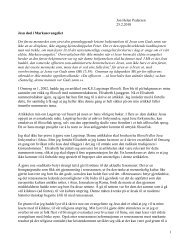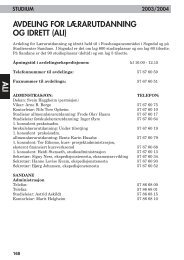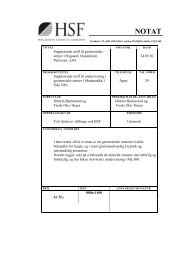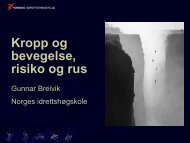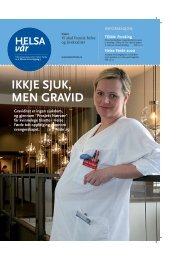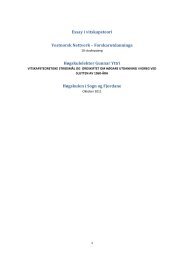Ressursbok i geometri for lærerutdanningen
Ressursbok i geometri for lærerutdanningen
Ressursbok i geometri for lærerutdanningen
Create successful ePaper yourself
Turn your PDF publications into a flip-book with our unique Google optimized e-Paper software.
- [W]hether it is wise to use "new," in the sense of very modern, mathematics is questionable.<br />
Mathematics which is used in engineering and science – in the design, <strong>for</strong><br />
example, of radar antenna systems, in determining the position and orbits of the satellites,<br />
..., and in the most esoteric <strong>for</strong>ms of theoretical physics – is really old mathematics,<br />
developed to a large extent be<strong>for</strong>e 1920.<br />
- "Ord":<br />
When we come to consider the words and definitions which children ought to learn,<br />
we should be careful not to teach "just" words. It is possible to give an illusion of<br />
knowledge by teaching the technical words which someone uses in a field ... without<br />
at the same time teaching any ideas or facts using these words. Many of the math<br />
books that are suggested now are full of such nonsense – of carefully and precisely<br />
defined special words that are used by pure mathematicians in their most subtle and<br />
difficult analyses, and are used by nobody else.<br />
...<br />
It will be very easy <strong>for</strong> students to learn the new words when, and if, they become<br />
pure mathematicians ...<br />
- Presist språk:<br />
The real problem in speech is not precise language. The problem is clear language. It<br />
is only necessary to be precise when there is some doubt as to the meaning of a<br />
phrase, and then the precision should be put in the place where the doubt exists. It is<br />
really quite impossible to say anything with absolute precision, unless that thing is so<br />
abstracted from the real world as to not represent any real thing.<br />
Pure mathematics is just such an abstraction from the real world, and pure<br />
mathematics does have a special precise language <strong>for</strong> dealing with its own special and<br />
technical subjects. But this precise language is not precise in any sense if you deal<br />
with the real objects of the world, ...<br />
- It will perhaps surprise most people who have studied the textbooks to discover that<br />
the symbol ∪ or ∩ representing the union and intersection of sets and the special use<br />
of the brackets { } and so <strong>for</strong>th ... almost never appear in any writings in theoretical<br />
physics, in engineering, in business arithmetic, computer design, or other places<br />
where mathematics is being used. I see no need or reason <strong>for</strong> this all to be explained<br />
or to be taught in school. ... It is claimed to be precise, but precise <strong>for</strong> what purpose?<br />
De kritiske røstene vi har nevnt, var <strong>for</strong>eløpig enslige røster i ørkenen.<br />
____________________________________________________________________________________________<br />
3.3 Re<strong>for</strong>m på retur<br />
Mot slutten av 1960-tallet hadde re<strong>for</strong>mbevegelsene vind i seilene som aldri<br />
før eller senere. Året 1967 nevnes som et høydepunkt(se [2], del V, s. 1).<br />
Det gjaldt både i USA og i Europa med Norden. Men kritikken fikk etter<br />
hvert større tyngde. Tidlig på 1960-tallet var kritikeren som sagt stort sett<br />
den enslige røsten i ørkenen. Og det var tro mot tro. Etter hvert kom det<br />
resultater av undersøkelser. En amerikansk undersøkelse på 1960-tallet<br />
omfattet 110 000 elever. Det lot til at regneferdigheten hos elever som fulgte<br />
et "moderne" opplegg var betydelig svakere enn hos slike som fulgte et tradisjonelt<br />
opplegg. (Riktignok var regneferdighet prioritert lavere i den første<br />
gruppen enn i den andre.) Begreps<strong>for</strong>ståelsen syntes å være litt bedre i den<br />
første gruppen. Når det gjaldt problemløsning, var resultatene "inconclusive".<br />
Etter om lag 1967 ble en del "moderne" opplegg <strong>for</strong>latt i USA.<br />
I avsnitt 3.1 omtalte vi Dieudonnés <strong>for</strong>edrag på Royaumontkonferansen<br />
i 1959, med bredsiden mot "Euklid". I 1970 kom en artikkel fra<br />
René Frédéric Thom (fransk matematiker, førende geometer, opphavsmann<br />
til den såkalte katastrofeteorien), meget kritisk til den "moderne"<br />
matematikken i skolen [10]. Det kom et svar fra Dieudonné i 1973 [1]. Når<br />
en leser disse to artiklene sammen, <strong>for</strong>står en bedre noe av det som lå bak<br />
re<strong>for</strong>mstrevet.<br />
Thom reflekterer blant annet over hva bevis og deduktiv tilrettelegging<br />
er <strong>for</strong> noe, og over "Limits and necessity of axiomatization". Av Dieudonnés<br />
svar blir det klart at når han dømmer "Euklid" nord og ned og insisterer på<br />
aksiomatisering selv i skolematematikken, så er hans anliggende ikke av det<br />
fundamentale filosofiske slaget som Thom har regnet med.<br />
Øistein Bjørnestad 2005<br />
17



